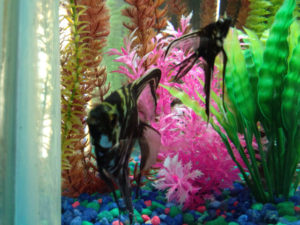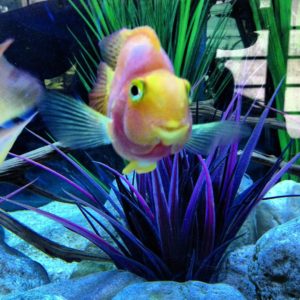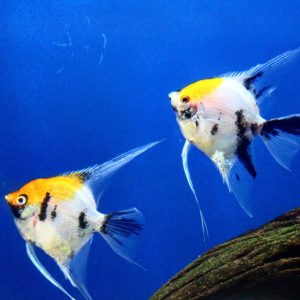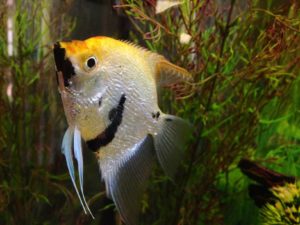How to take care of Angelfish? Angelfish can be a difficult fish to care for because they are sensitive to changes in water quality, temperature, and unsanitary conditions.
Tank size is important when choosing the angelfish’s tank. Angelfish are territorial, so if you have more than one of these fish in a tank, provide each with at least one gallon of space and make sure there’s plenty of room for them to swim around. When choosing a new angelfish, don’t buy two different species that require vastly different water parameters. For example, don’t purchase an angelfish from a brackish water habitat and an African Cichlid from a freshwater home; this will lead to trouble for the angelfish.
Angelfish and temperature changes
Angelfish can be sensitive to abrupt temperature changes, so make sure you acclimate them gradually. You want the tank temperature to stay between 72-78 degrees Fahrenheit (22-26 Celsius), though there are some angelfish that will tolerate a little warmer water.
Most Delicate Aquarium Fish:
The angelfish’s body is scale less and can easily be damaged. Be careful when observing your angelfish, and never shine bright lights in their eyes or expose them to toxic chemicals.
Angelfish like to have a cave they can hide inside, so consider purchasing an artificial rock as decoration for the tank. Because lighting is important for angelfish (but generally not heat), put the light bulb near the tank so they can get to it easily.
New Angelfish
When choosing a new angelfish, you should choose one that is already quite comfortable in water (such as a fully-grown fish or one that has been quarantined). You will need to acclimate your angelfish gradually; exposing them to warmer water for five minutes per gallon of water in the tank for a period of three to four hours.
A pH level between 6.0-7.5 is best for angelfish, and the ideal temperature should be maintained by using an aquarium heater and thermometer; it should stay between 72-78 degrees Fahrenheit (22-26 Celsius). You may also want to buy a chemical test kit to monitor your water quality.
Angelfish also need to be fed weekly:
Angelfish also need to be fed weekly, and a good diet should consist of pellets, flakes, or frozen foods including bloodworms; you can also feed them insects such as crickets if they are available.
An angelfish’s tank should be spayed between 20-30 percent and have plant material in it for them to hide in. They probably won’t eat the plants, but they will use them as a place to sleep.
After choosing an angelfish and housing it properly, you can begin giving your new pet the care it needs by checking your tank’s water every day; this will help you detect any problems early on.
Angel fishes for sale
Angelfish, also called clownfish, are saltwater fish that live in warm waters that contain reefs. They are usually orange or yellow and can be found anywhere in the ocean. Some species are very difficult to locate, such as the Wolffish. Most angelfish species stay within a close vicinity of the reef or other habitat.

The most important thing about angelfish is the fact that they can be very territorial and aggressive when it comes to their home. There is a risk of injury if you do not observe them from a distance and never attempt to handle them. It’s generally not recommended for children to interact with these animals as they have poisonous spikes on their fin; this is why they are known as “clownfish”.
The angelfish holds many different characteristics that make it very unique. For one, when the male angelfish is in a territory with other males, they will be aggressive to each other and there may even be fighting over who gets to date the female of their species. Females are also very selective when looking for a mate;
some can even go months without finding the right mate. This can be quite problematic when you compare it to other animals that have a mating ritual which lasts only minutes. Because of this, human interaction with these fish is limited and there are rarely any cases where they are kept as pets.
Angel fishes Life Span
The angelfish has been known to live over ten years in captivity, but some have been known to live up to twenty years. This is quite a feat considering the average life expectancy of an angelfish in the wild is only 18 months.
There are over 6 species of angelfish that occur off the coast of Florida and around 200 in total throughout the tropical waters.
Most commonly found in the family Pomacanthidae, there are three main groups of angelfish, all represented off the coast of Florida.
The Bluestreak or Cobaltoanangel: These are actually a type of damselfish that is rarely seen in captivity due to their aggressiveness and territorial nature. They’re small with blue-grey or black-green bodies.
The Spectacular
These are the common angelfish that most people would recognize. They’re yellow with blue faces and can be found in a variety of shapes, sizes, and colors. The average life span is about 3-4 years in captivity.
The French: This fish (tropical fish is very similar to the Spectacular, but has a white face instead of blue. The patterns on their body can also be more vivid than those of the Spectacular. They’re slightly smaller than the Spectacular too, and have more finnage.
The Black and White:
The Black and White: This angelfish is one of the most common in captivity because they are very easy to care for and have very few health issues. They’re dark brown with white stripes and are small in size compared to most angelfish species.
Angelfish breeding
Angelfish breeding is the process, which aims to produce angelfish eggs for human consumption. The angelfish are bred in captivity in a closed body of water such as a tank or an aquarium. These fish can be found in many shapes and sizes but they most popular ones are Queen angels. The average size of the queen angelfish is 14 centimeters. This fish species has a lifespan between 5 to 10 years and it produces batches of 100 eggs approximately every three days.
The egg hatching period is between 20 and 30 days. It takes about 4 months for the larvae to reach maturity from eggs, so if you want them to grow faster, you should use food with more protein for the fish.
The most important thing about angelfish breeding is that you have to get some experience and learn how to take care of them by yourself, because if there are no experienced people around, they may die in a couple of days.
Angel fish aquariums
An angel fish aquarium is a beautiful addition to any home. While they’re not as popular as other items on the market, there are many advantages that come with buying an angel fish aquarium. There are also some things that you need to know before purchasing an angel fish aquarium.
Angel tanks can be small or large, and all require different types of maintenance depending on the size of the tank and how many fish are in it. The most important part of a tank is the water. Without clean and clear water, your fish will not survive for very long.
When buying an angel tank you need to make sure that it comes with everything that you need to have a successful aquarium. Some tanks only come with a filter system and no heater while others come with their own lighting system. You need to make sure that you look through the tank and see everything than it comes with, and if there is something missing then go ahead and buy it separately.
You also need to make sure that you give your angel tank the right amount of water. This means that if you’re using a 20-gallon tank, then only put in 10 gallons of water because this will allow you to be able to change the water out more frequently without over filling the tank and stressing your aquarium fish.
How to get started on a freshwater angelfish tank?
The aquarium is the most important part of your freshwater angelfish aquarium.
A marine angelfish requires a large aquarium with plenty of room to swim and places for plants and decorations. You may wish to start with an aquarium that is already established if you are just starting out with freshwater aquariums.
The best way to know what size tank is appropriate for your angelfish is to research the species that you would like to keep. There are many different varieties of freshwater angelfish available, and they come in a variety of colors and sizes. Some will grow to be very large (5 or 6 inches), while others are smaller freshwater angelfish aquarium fish (2 or 3 inches) freshwater angelfish. You can find freshwater angelfish that have blue, black, yellow, white and orange colors.
You will need to research your freshwater angelfishes’ needs before you purchase them. Some freshwater angelfishes require live plants in the freshwater angelfish aquarium. If you are unsure, research freshwater angelfish plants or other recognized freshwater fish to see if they are a good fit for your aquarium.
People often keep them in an aquarium as a decorative piece (as a freshwater aquarium fish) or for research. They are often kept in schools and zoos because they are easy to care for and can be fed most anything.
Are there wild caught angelfish?
If you’re looking for pet angelfish, you might find it in the “wild caught” category. Check with your local fish store owners or aquariums to see if they have any. If you’re interested in the “wild caught” angelfish, there are things to consider before buying one.
The first thing to consider is what the “wild-caught” means? Are you okay with the fish being wild caught or do you want fish that has been captive bred (CB)? Some people don’t mind – and some people are set against buying fish that is wild caught. There’s a long discussion about whether it’s ethically right to take fish from the wild and put them in captive environment, so I urge you to research the pros and cons before you decide.
CB angelfish
If you’re buying CB angelfish, make sure they come from a reputable fish breeder. Angelfish can be difficult to breed in captivity and some fish are more likely than others to reproduce. The less you pay for CB angelfish, the more likely it is that they are not genetically sound (if that matters to you).
Wild caught angelfish.
If you’re buying wild caught angelfish, do your research to find out how the angelfish were caught. If fish were taken from their home by a trawling net, that’s not good. However, if the angelfish are being collected for take home aquariums (i.e., there is no other way to get them except collecting wild), it might be okay with you.
As with most fish you’ll find in the wild, angelfish are probably unhealthy and a bit stressed out when they’re taken from the wild. It’s up to you whether or not it’s worth the effort to try to save their lives. If your heart is set on rescuing one, there are things you can do to help rehabilitate it.
Keeping freshwater angelfish
I have a freshwater angelfish and have had one for about 8 months now. I clean their tank once a week and feed them every other day. I also have a molly and a few cory cats. They all get on fine except sometimes the angelfish nips at the molly’s tail fin. It doesn’t seem to bother her though as she is always chasing the cory cats. I have kept fish for years and this is one of my favourite ones to keep as they are so pretty.
Most captive angelfish
Angelfish are freshwater tropical fish that need an aquarium with a temperature between 72 and 82 degrees Fahrenheit. You can’t keep them in water below 68 degrees or over 86 degrees, so be careful when you set up your tank! The pH level should be 6.5-7.0, but they do well in slightly acidic conditions too (6.0-8.0).
Angelfish like to swim
Angelfish like to swim around the top of the water column while eating things like shrimps, snails, worms and small insects. They’re omnivores which means they will also eat plants if offered to them! An angelfish’s diet is usually prepared for it by sinking food pellets into the tank for it to nibble on at its leisure.
Angelfish will grow to be around six inches long and should always be kept in groups of 3-5 or more. They can breed and produce little angelfish if they’re conditioned right, but the process takes a while! When you put two male adult angelfish together it’s best to increase their tank size to 55 gallons or more because of their intense urge to breed.
Females can be kept with males after they’ve reached adulthood, but cannot breed at all (only the two males in their group will go through a mating ritual). The female angelfish’s egg production varies between each individual fish- some produce eggs every week and others won’t lay eggs for months!

